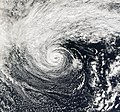Datei:Storm 91C 01 nov 2006 2030Z.jpg

Größe dieser Vorschau: 642 × 599 Pixel. Weitere Auflösungen: 257 × 240 Pixel | 514 × 480 Pixel | 823 × 768 Pixel | 1.097 × 1.024 Pixel | 2.194 × 2.048 Pixel | 6.000 × 5.600 Pixel
Originaldatei (6.000 × 5.600 Pixel, Dateigröße: 5,91 MB, MIME-Typ: image/jpeg)
Dateiversionen
Klicke auf einen Zeitpunkt, um diese Version zu laden.
| Version vom | Vorschaubild | Maße | Benutzer | Kommentar | |
|---|---|---|---|---|---|
| aktuell | 20:58, 2. Jan. 2010 |  | 6.000 × 5.600 (5,91 MB) | Supportstorm | Reverted to version as of 00:19, 3 November 2006 |
| 22:41, 29. Dez. 2009 |  | 6.000 × 5.600 (5 MB) | Supportstorm | Image Adjustment: Auto levels on contrast and color | |
| 02:19, 3. Nov. 2006 |  | 6.000 × 5.600 (5,91 MB) | Good kitty | == Summary == {{Information |Description=Tropical storms, as their name suggest, tend to form in the tropics. However, from time to time similar looking storms can form at higher latitudes. Extratropical storms have cold rather than warm cores and usually |
Dateiverwendung
Die folgende Seite verwendet diese Datei:
Globale Dateiverwendung
Die nachfolgenden anderen Wikis verwenden diese Datei:
- Verwendung auf en.wikipedia.org
- Verwendung auf en.wikinews.org
- Verwendung auf nl.wikipedia.org
- Verwendung auf pt.wikipedia.org
- Verwendung auf simple.wikipedia.org
- Verwendung auf tr.wikipedia.org
- Verwendung auf www.wikidata.org
- Verwendung auf zh.wikipedia.org

